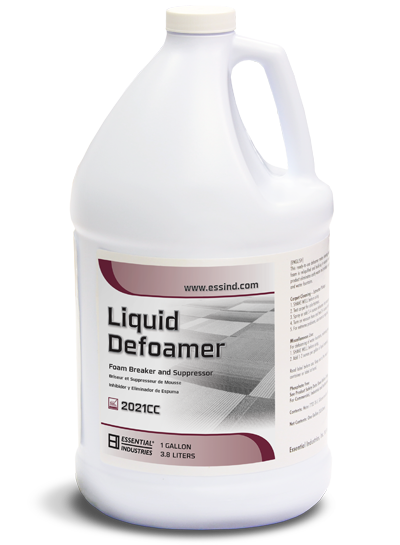The Newest Innovations in Chemical Defoamer Formulation for Improved Performance
Discovering the Conveniences of a Chemical Defoamer in Production and Manufacturing
The assimilation of chemical defoamers in manufacturing and manufacturing procedures provides a calculated advantage by dealing with one of the relentless difficulties in commercial operations: foam control. As makers strive to optimize processes and boost customer complete satisfaction, the role of chemical defoamers comes to be significantly vital.
Relevance of Foam Control
While the visibility of foam in manufacturing procedures can often appear harmless, reliable foam control is critical for optimizing functional effectiveness and item top quality. Foam can conflict with different stages of production, resulting in ineffectiveness that might raise prices and prolong processing times. In industries such as food and drink, drugs, and chemicals, unchecked foam can block tools, interrupt automated systems, and ultimately result in item disparities.

Applying effective foam control approaches not only enhances efficiency but also sustains regulatory compliance in industries where foam can result in ecological concerns. By utilizing chemical defoamers, manufacturers can reduce these difficulties, making sure smoother procedures and higher-quality output. Ultimately, prioritizing foam control is an essential aspect of manufacturing that can yield considerable benefits in regards to effectiveness, security, and item reliability.
Kinds of Chemical Defoamers
What kinds of chemical defoamers are readily available for producing processes, and how do they vary in application? Chemical defoamers can be classified right into 3 major types: silicone-based, organic, and not natural defoamers. - Chemical Defoamer

Organic defoamers, usually originated from fatty acids or natural oils, work in a variety of applications, including food and beverage production. They are usually preferred for their lower toxicity and environmental influence, making sure compliance with market regulations.

Each kind of defoamer serves distinctive functions based upon the chemical structure and the details needs of the production procedure, permitting producers to pick one of the most ideal option for their particular requirements.

Advantages in Production Efficiency
Chemical defoamers play an important role in enhancing making efficiency by successfully controlling foam generation during different procedures. Foam can hinder production rates, interfere with devices procedure, and bring about expensive downtime. By including chemical defoamers, makers can reduce these issues, guaranteeing smoother process and boosted overall productivity.
Using chemical defoamers assists maximize the operational efficiency of equipment such as mixers, pumps, and reactors. With decreased foam, these devices can run at their intended ability, lessening the risk of overflow and enabling regular processing. This leads to much better resource application and higher throughput.
Moreover, chemical defoamers facilitate faster processing times by decreasing the moment needed for foam removal. This acceleration can dramatically influence production routines, permitting manufacturers to fulfill customer demand extra efficiently. In addition, making use of defoamers contributes to reduce power consumption, as equipment runs a lot more successfully with minimized foam disturbance.
Effect On Product Quality
Foam control is not only vital for maintaining efficiency in producing procedures however also plays a significant duty in guaranteeing product top quality. Too much foam can present air into formulas, bring about incongruities in the end product. This can show up as problems such as voids, uneven structures, have a peek at this website or poor finishes, which weaken the desired high quality and efficiency of the item.
Furthermore, foam can prevent the homogeneity of combinations, leading to uneven distribution of active components. In industries such as coverings, cosmetics, and food production, this can result in variants in shade, preference, and general effectiveness. By using a chemical defoamer, makers can mitigate these threats, guaranteeing that products meet rigorous high quality requirements.
In addition, regulating foam can boost the stability of emulsions and suspensions, which is crucial for ensuring shelf-life and consumer contentment. With enhanced item consistency and decreased issues, suppliers can attain higher requirements of high quality guarantee, eventually leading to boosted customer trust and brand loyalty.
Cost-Effectiveness and ROI
Efficient foam control not only enhances item quality but also contributes substantially to the total cost-effectiveness of making processes. The use of chemical defoamers reduces foam-related concerns, which can otherwise bring about production hold-ups, equipment malfunctions, and raised power usage. By decreasing foam, suppliers can optimize their processes, causing greater throughput and effectiveness.
Investing in chemical defoamers can produce a substantial return on investment (ROI) The initial expenses associated with these ingredients are commonly offset by the financial savings realized from lowered downtime and enhanced product return. Furthermore, improved product high quality can decrease waste and remodel prices, even more bolstering monetary performance.
In addition, effective foam control can cause lowered water and power use, adding to lower functional expenses. This is specifically crucial in industries where source performance is paramount. By integrating chemical defoamers right into their procedures, producers can achieve lasting financial savings while maintaining affordable rates in the industry.
Verdict
In conclusion, the assimilation of chemical defoamers in manufacturing and manufacturing procedures is essential for maximizing have a peek at these guys operational effectiveness and improving product quality. The advantages supplied by chemical defoamers not just sustain regulatory conformity but also provide a competitive edge in the manufacturing landscape.
The assimilation of chemical defoamers in production and manufacturing procedures uses a critical benefit by addressing one of the persistent difficulties in industrial operations: foam control.While the existence of foam in making see page procedures can occasionally appear safe, effective foam control is crucial for maximizing operational efficiency and item high quality.Chemical defoamers play an important role in improving producing effectiveness by successfully controlling foam generation throughout various processes.Furthermore, chemical defoamers help with faster processing times by reducing the time required for foam elimination. Additionally, the usage of defoamers adds to decrease power intake, as equipment operates extra successfully with minimized foam disturbance.